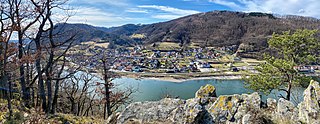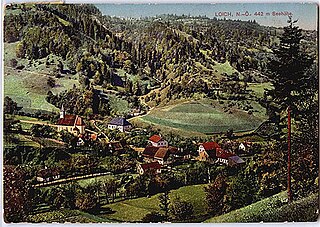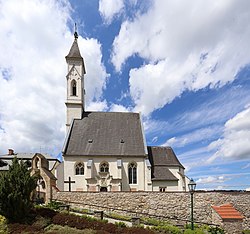
Aggsbach is a small wine-growing town in the Krems-Land district of Lower Austria, Austria. As of 2001, it has a population of 714 and an area of 13.72 km.² Aggsbach was first mentioned in an 1148 document calling it "Accusabah".

Nenzing is a market town in the district of Bludenz in the Austrian state of Vorarlberg with a population of 6,225 (2022).

Ebenthal in Kärnten is a town in the district of Klagenfurt-Land in the Austrian state of Carinthia.

Bad Deutsch-Altenburg, until 1928 Deutsch-Altenburg is a market town and spa in the district of Bruck an der Leitha in Lower Austria in Austria.

Trautmannsdorf an der Leitha is a town in the district of Bruck an der Leitha in Lower Austria in Austria.

Glinzendorf is a town in the district of Gänserndorf in the Austrian state of Lower Austria.

Großhofen is a town in the district of Gänserndorf in the Austrian state of Lower Austria.
Hohenau an der March is a town in the district of Gänserndorf in the Austrian state of Lower Austria, close to Vienna and the borders with the Czech Republic and Slovakia.

Raasdorf is a town in the district of Gänserndorf in the Austrian state of Lower Austria.

Senftenberg is a town in the district of Krems-Land in the Austrian state of Lower Austria.

Bernhardsthal is a town in the district of Mistelbach in the Austrian state of Lower Austria.

Kreuttal is a town in the district of Mistelbach in the Austrian state of Lower Austria.

Poysdorf is a town in the district of Mistelbach in the Austrian state of Lower Austria.

Achau is a town in the district of Mödling in the Austrian state of Lower Austria.

Gießhübl is a town in the district of Mödling in the Austrian state of Lower Austria. It is located in the south of Vienna, the Austrian capital, neighboring the nature protection area Föhrenberge. With an altitude of 416 m, Gießhübl is the highest-located wine-growing district in Lower Austria. Originally Gießhübl was an agrarian village. Today it is mainly a residential area because of its vicinity to Vienna and the direct connection to the highway A21.

Kaltenleutgeben is a town with a population of 3302 in the district of Mödling in the Austrian state of Lower Austria.

Scheiblingkirchen-Thernberg is a town in the district of Neunkirchen in the Austrian state of Lower Austria.

Warth is a town in the district of Neunkirchen in the Austrian state of Lower Austria.

Eichgraben is a town in the district of Sankt Pölten-Land in the Austrian state of Lower Austria.

Loich is a town in the district of Sankt Pölten-Land in the Austrian state of Lower Austria.






















